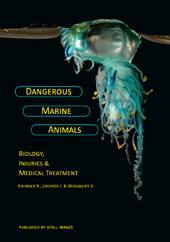European travel and tourism group TUI has awarded the Eco-Centre at Kuramathi its ‘International Environmental Award’, “recognising its exemplary contribution to the protection and conservation of nature and biodiversity” and in particluar its work protecting coral reefs in the Maldives.
The award, which includes a prize of €10,000 (US$13,500), was presented during a ceremony held at the resort yesterday attended by President Mohamed Nasheed.
While many resorts in the Maldives now run eco-centres and environmental awareness programs, a trend that has grown in parallel with the increasing eco-awareness of guests from leading markets such as the UK. The Kuramathi centre, currently headed by Dr Reinhard Kikinger, is one of the oldest such facilities in the country. It was founded in 1999 by Director of Universal Resorts Ali Noradeen, in response to catastrophic coral bleaching caused by the el Niño effect which destroyed 95 percent of the country’s shallow reef coral – a disaster from which the country’s coral is still recovering.
“Water pollution and over exploitation through tourism can lead to irreparable damage,” TUI said in a statement following the event.
“The compelling concept of the Kuramathi Eco Centre was bringing nature conservation and tourism into harmony based on research, the sustainable use of resources and the raising of public awareness, which are performed in cooperation with TUI and the local population.”
Eco-conscious trend
Many resorts in the Maldives now run eco-centres and environmental awareness programs, a trend that has grown in parallel with the increasing eco-awareness of guests from leading markets such as the UK.
Marine biologist Verena Wiesbauer Ali, currently a consultant with Male’-based Water Solutions but who has worked at resorts all over the country, explained that the concept of running an eco-centre and employing a resident marine biologist was one that took off in the Maldives after increasingly eco-conscious guests began to ask more and more questions of resort staff.
“The first centre was opened at Kuramathi, but in 2009 I counted 12-15 centres at resorts across the Maldives. There will be many more by now,” she said.
Many of the marine biologists and eco-centres in the Maldives communicate with each other over a lively online newsgroup, reporting aquatic abnormalities and swapping tips on how to convince resort managements of the potential impacts of practices such as manta and sting ray feeding exhibitions (with one suggesting that feeding mantas leads them to mob snorkelers, who can panic and potentially stand on a sting ray).
Initially, Wiesbauer said, there was an assumption among many resorts that a marine station generated no income and was just “a luxury addition” to the resort – “but I believe that if run properly, they do [generate revenue] – I did my Masters thesis on it. ”
Guided dives and snorkel tours, and presentations on marine life and reef protection, might be the most self-evident activities of a marine station or eco-centre, Wiesbauer explained, but broadening the role of marine biologists to incorporate other aspects of the resort could greatly improve its sustainability – literally, in cases of beach erosion.
“As well as guiding snorkeling tours they can help improve things like energy efficiency, and even things like the purchasing department – for example, there are currently a lot of illegal transactions going on around the purchase of lobsters [from local fishermen]. Only a few resorts have asked their marine biologists to make sure the lobsters they are buying meet minimum size limits.”
Some resorts, Verena noted, were heavily involved in marine research – with academic work carrying the potential to greatly enhance the prestige of a resort.
“For a resort to fully benefit, the marine biologist has to be involved in many departments,” she explained. The end result – ‘going green’ – was a highly marketable benefit in key European markets such as the UK, and at upmarket resorts such as Soneva Fushi, a key feature of the resort.
A rising trend at many resorts with eco-centres was to develop them into focal points for environmental awareness programmes and marine biology classes in nearby communities and schools – effectively exporting the resort’s eco-knowhow to the community, as the Kuramathi centre does with neighbouring Rasdhoo.
“This is something that is especially important for resorts in the outer atolls,” Wiesbauer said, observing that in her experience many local teachers lacked enthusiasm for the field work and expeditions needed to bring the subject alive for young students.
“Mostly it is taught [in the Maldives] as a scientific, book-based subject, and the kids say it is not being made clear to them. Things like the nature expeditions for schools organised by Soneva are very successful.”
However resorts, she acknowledged, were very different from each other and not all had the scope for an in-house marine biologist – some relied on visiting consultants, others disregarded the concept altogether.
“Some resorts focus on diving and snorkelling, while at others guests hardly ever go in the water,” Wiesbauer said.
Nonetheless, she suggested, while there was a balance to be struck between sustainability and providing the five star luxuries such as monsoon showerheads that many guests expected, it was important to provide visitors a choice when it came to simple things – such as reusing towels. Far from feeling inconvenienced, guests were usually very supportive of such measures, she said: “across all the resorts I’ve worked, I haven’t once had a guest come up and say to me ‘I’ve paid thousands to be here, I can do what I like.’”
Correction: An earlier version of this article incorrectly stated that Verena Wiesbauer Ali was presently completing her Masters. She has completed her Masters and is now working on her PhD.
